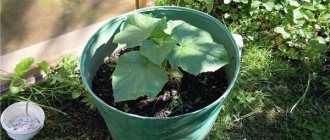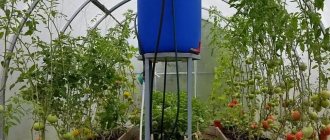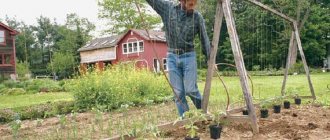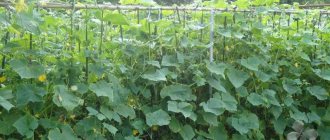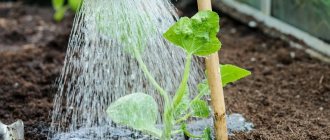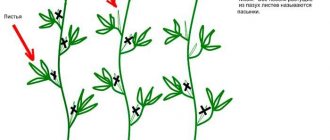Both experienced and novice gardeners must carry out mandatory gartering of cucumbers. It prevents rotting of unripe fruits. The garter simplifies the care of cucumbers and subsequent harvesting. However, this procedure, especially for an inexperienced gardener, must be carried out very carefully so as not to damage the main stem of the plant.
Why do you need a garter of cucumbers in a greenhouse?
Cucumbers are liana-like plants. For normal growth and development, they need to be tied up.
This is done for several other reasons:
- Makes caring for the plant easier.
- Intertwining of plants is prevented.
- Planting density decreases.
- It becomes possible to control the number of female and male flowers.
- Aeration inside the bush improves.
- The risk of putrefactive formations is reduced.
- The harvesting procedure is simplified.
- The number of fruits increases.
You will learn how best to garter cucumbers from this article.
Bush formation, pinching
When forming a bush, the main stem is attached to the trellis so that the vines on the side develop before the first ovaries appear. After this, the shoots located on the side need to be pulled towards the main stem. The tendril that extends from the main shoot must be twisted several times laterally by hand.
In the future, it is necessary to periodically repeat such garters. Unnecessary shoots should be removed in time.
The side shoots are pinched before they increase in length by 20 cm. The apical part must be carefully cut off so as not to touch the plant. This method is also used for antennae and sinus stepsons. The procedure for pinching cucumber lashes:
- the first 40-50 cm of the bush “blind” completely;
- after the next 40-50 cm, pinching is done above the first leaf;
- after another 40-50 cm, pinch over the second, and then over the third.
If the above plant care measures are not carried out, this will negatively affect the condition of the bushes and the quality of the future harvest.
Correct timing for tying cucumbers
After the seedlings are planted in the ground and the stem length has reached 25-30 cm, you can begin the tying procedure. Usually by this time the plantings already have 4-5 full-fledged leaves, and the root system is sufficiently strong and capable of supporting the bush. It is important to provide supports for cucumbers in a timely manner; the stem spreading on the ground can also take root, like its liana-like tropical relatives.
The bush is tied early in the morning, before the sun begins to become active.
When should you start tying?
The process of tying cucumbers should begin 3-4 weeks after the start of their growth, when the height of the plant approaches 32-35 cm. It is better to do tying on time, without delaying it until later, since it is much easier to work with young cucumbers due to the elasticity of the stem, and fully mature plants are damaged when bent.
Gather all the necessary supplies for the construction of supports, which should be built before planting the seedlings. When caring for bushes, you can choose any garter option. The choice of the optimal method depends on the variety of plant being grown, the size of the area where the bush grows, and the availability of the necessary equipment for the upcoming gardening operation.
Required materials and tools
You can easily find everything you need for tying cucumbers on your site:
- Wooden beams, logs. You need to take hardwood. It is also important to treat them with an antiseptic before burying them in the ground. Installation depth - no less than 0.6 m.
- Metal pipes. To protect them from corrosion, they are coated with oil paint and special products. When installing, use a garden drill to make a hole up to 0.5 m. Then drive it a little into the soil, about another 20 cm. The voids around the post are filled with earth and compacted.
- Cement pillars. It is necessary to use formwork and build it in stages, so their use is practically not practiced.
- Twine or twine.
- Fabric cut into shreds.
- Carnations.
- Low wooden pegs.
- Pliers and hammer.
If you plan to hang the whips on a mesh (lattice), you can purchase it for little money at a socialized store. Hooks for securing the vines in the cell are additionally purchased there.
Trellis method
Important! You should not use thin wire for tying; it can cut the delicate stems of the shoots.
What to tie it to
Various materials are used for tying cucumber bushes:
- On the splits . The material is easy to use and does not rot. The twine is installed vertically, attached from above to the profile of the greenhouse, and from below to the peg. The lashes are not fixed very tightly under the second or third sheet at a distance of 30 cm from the ground.
- On the fence. Cucumbers are less often tied this way, but the device is convenient to use. A strong net placed on high stakes is stretched along the cucumber row. The bushes are attached to the net using a rope. Cucumber stems can be staked at different levels as they grow.
- On the arcs. It is very convenient to tie cucumbers to arcs that are installed above the cucumbers. To create such a simple device, bent rods are used, which are placed near each cucumber row. The stems of the plant are attached to the support using stretched ropes.
- On the grid. Modern gardeners successfully use netting for tying cucumbers. It is better to give preference to a mesh with holes of at least 10 cm. It can be plastic or in the form of a metal mesh fence along which vegetable crops will weave.
- On the trellises. The trellis design is more practical and reliable, as it includes additional supports that help hold large volumes of ripe fruit. Depending on the need and variety of cucumbers, a trellis of any shape is selected.
Methods for tying cucumbers in a greenhouse
Gardeners identify several main ways in which cucumbers can be tied up in a greenhouse. These include:
- vertical;
- horizontal;
- mixed;
- twine;
- on the fence;
- on the arcs.
Any of these schemes is suitable for a polycarbonate greenhouse, it all depends on the area of your structure.
Let's dwell a little on each of them.
Vertical tying
Most often used in spacious greenhouses with a ceiling height of at least 2.5 m.
To form the frame, support posts 2 m long are dug in at both ends of the bed. A transverse plank is attached to the top of them. The design resembles a capital letter P. If the bed is long, then an additional vertical support must be placed in the middle of it. From the transverse bar, pre-attached pieces of twine are lowered down to the ground, along which the cucumber vines will stretch upward. Their number depends on the density of plantings; each bush should have its own support.
Some gardeners prefer not to make a solid structure, but to drive a peg from floor to ceiling under each plant so that the stem goes up it. For reliability, it is tied to a peg using pieces of fabric. It is advisable to pinch the tops of the plants when they reach the top point.
Vertical tying helps to form a bush that is easy to care for, provides sufficient levels of moisture and light, and facilitates the harvesting procedure.
Horizontal tying
This method is widely used in low greenhouses and greenhouses with a small number of plantings.
To form the frame, high supports are driven into the sides of the bed, onto which a rope is pulled 30 cm from the ground. Some gardeners use wire. The main thing is that it is wide enough and does not damage the stems. The next row is stretched another 35 cm higher and so on until the end of the support under the roof. It is recommended to add 5 cm to each next step. The grown bushes are directed onto horizontal supports, twisting clockwise.
An important condition is to pinch the lateral shoots so that they do not cling to the upper steps and do not lead to tangling of the plantings.
The disadvantage of this method is that dense plantings produce too dense bushes, which must be constantly pinched and excess shoots removed. If too many vegetative parts grow, harvesting will not be very convenient.
Mixed tying
This method is not very common among gardeners and consists of making a cone-shaped support. It is mounted by digging ten metal rods or wooden pegs in a circle. This must be done before the seedlings are planted in the ground, otherwise there is a high probability of damaging the delicate roots of the cucumbers.
Each planting has its own peg. As soon as the seedlings reach 25-30 cm in length, they are twisted clockwise near the peg, if necessary, tied to it with pieces of fabric for reliability. It turns out to be a kind of cucumber hut. This option is unlikely to be suitable for a greenhouse; most often it is used in open ground.
Pyramidal
Another method is pyramidal, which has a vertical growth orientation. 7-10 pegs are dug into the ground around the circumference, which are fastened together at the top of the structure. A special mesh is placed on top of them or the rods are intertwined with rope at a sufficient distance from each other. Your cucumbers will grow along these elements, as a result of which the bush will take a bizarre pyramid shape.
You can build such a structure in a simpler way by driving one peg into the ground and tying several ropes to it. Their ends need to be secured to the ground in a circle; the number will depend on the volume of plantings. This method allows you to combine from 15 to 20 bushes without loss of usable area or damage to their growth.
Using twine
Twine is often used as an independent material for making supports for cucumbers. If there is a beam running under the roof of the greenhouse, then you can attach plastic hooks to it and tie twine into a knot. Its free end is attached to the cucumbers with a loop above the third leaf. If there is no beam, then several pegs can be placed in the greenhouse to which the twine thread will be tied.
Trellis
Let's look at it step by step. You will need to make a U-shaped frame from wooden support pegs 2-2.5 m high. It will serve as the basis for the future trellis. To make cells, you can take fabric. Some gardeners sew the patches together before the start of the season to create a net. All that remains is to nail it to the beams. But the strength of such a design is questionable.
To make a trellis, it is best to take long branches and twigs, previously cleared of bark and knots. They are nailed to the top bar. The step distance depends on the planting density. The lower end of the rod is dug into the ground. Then a mesh is formed using wire and remaining branches. It can also be made using thin wooden slats or thick twine.
Use of a fence
Fences have recently been rarely used for tying cucumbers. To create such a support, take a mesh with large cells and stretch it between two pegs driven in the middle of the edges of the bed. A separate cell is used for each stem.
It is quite simple to tie up such a bush, but the design does not have the most advantageous location and requires financial costs, albeit small ones.
Tying on arches and blinding
Arches are most often used in open ground beds. For them, you can take thin polypropylene pipes or purchase a ready-made structure in the store. Arcs are dug into the bed along its length; their number should depend on the number of plants.
If they are tall, you can lower ropes from them to the ground, one for each stem. Blinding is carried out when the central stem is attached to the trellis. Only after this, all lateral processes and shoots in the apical part are removed.
How to tie cucumbers in a greenhouse
Often, “supports” are already included in the design of greenhouses. Their role is played by auxiliary supports and other elements. Therefore, basically the garter methods are the same as those suitable for the greenhouse. The most commonly used method is the vertical method , in which the stems are tied to the top crossbar of the greenhouse. Alternatively, you can make holes in the roof and pass a rope through it with a loose knot. It is needed in order to regulate the degree of tension and, if necessary, loosen or strengthen it. Strips of fabric or twine are lowered from the rope and used to tie the cucumbers. It is very convenient to tie up plants in a greenhouse using a mesh tent or arcs that are part of the structure.
Unusual ways to tie cucumbers
In addition to the classic methods, there are also not quite ordinary ones that also deserve attention:
V-shaped
A peg is driven into the base of the planting. From which two ropes extend in the shape of a jackdaw and are attached to the ceiling.
Decorative
An art object is created from wooden slats or iron rods, for example, a cube, inside of which cucumbers are planted. The lashes wrap around horizontal and vertical elements on the outside of the structure.
Bochkova
Soil is poured into the barrel where the cucumbers are planted. You can take a barrel without a bottom, which is much more convenient. Growing lashes simply go down the walls. You just need to make sure that they do not intertwine with each other.
Shaped like a tree
The lower part of the bush is tied to a support with a single trunk, and then the lashes diverge along ropes pre-tied at an angle of 60 degrees, creating the effect of a crown.
How to tie cucumbers on the balcony
Proper garter of cucumbers is especially important for growing this crop at home. This method has several specific varieties that help to grow a healthy plant with a sufficient number of fruits.
1. Trellis ladder . You can tie the plant vertically using a homemade or purchased mini-trellis. It resembles a toy ladder and is inserted directly into the container with the bush. The plant immediately rests on it and begins to actively grow upward. You can also insert a support stick .
2. Mobile trellis . Typically, any high U-shaped structure is used for this, from the crossbar of which strips of fabric are hung for garter. Such a module made of wood or metal can either be installed above a group of plants in pots, or fixed directly into a container with a specific plant.
3. Attaching to clotheslines . Most of us already have a ready-made trellis structure on our balcony - these are stretched ropes for drying clothes. It is to them that you can attach cucumber shoots, having previously lowered twine or strips of fabric from above.
As you can see, there are many ways to garter cucumbers. You can combine several methods and, through trial and error, choose the right option for yourself, and the plants will give you a significant harvest of strong, crisp cucumbers.
Step-by-step instructions for gartering cucumbers in a greenhouse
Gartering cucumbers in a greenhouse is a must if you want to get a tasty and rich harvest. But the procedure must be carried out step by step, observing all the subtleties and rules:
- Two weeks after planting, cucumbers need to adapt to new conditions.
- After the stem grows to 30 cm, it is directed to the support, twisting clockwise.
- Everything that grows below the fifth leaf must be removed in a timely manner.
- Shoots are removed from leaves 4 to 7. The ovaries remain.
- Above the seventh leaf, ovaries and shoots are left until one ovary and a leaf are formed on them, after which pinching is carried out. The cut areas should be thoroughly disinfected with a solution of potassium permanganate.
- Every next three leaves, the number of leaves and ovaries left increases by one. And so on, growing to the edge of the support beam.
- The top of the cucumber is either pinched or thrown over a beam and directed towards the ground.
If tied cucumbers are not pinched or pinched, strong thickets will form, which will reduce the yield.
Is it possible to grow cucumbers without a garter?
So, we found out how to tie cucumbers in the garden and in the greenhouse. But, probably, many are still concerned about the question - is it possible to do without forming supports for cucumbers? In some farms this method is practiced and, according to its supporters, it works quite successfully. Yes, cucumbers can freely spread along the ground, choosing a “horizontal” form of existence. But they always lie underfoot, in dust, vulnerable to rot and other diseases, pests and rodents. The leaves cover the fruits, thickening occurs, the garden bed looks untidy, and one can only dream of a bountiful harvest. Decide for yourself whether you need such “experiments”?
Mistakes you shouldn’t make when tying cucumbers in a greenhouse
Some novice gardeners make a number of common mistakes when tying cucumbers:
- Extended deadlines. The taller the plant becomes, the more difficult it is to tie it to a support, since the stem becomes rigid and bends poorly. Recommended planting length to start with
- Violation of the growth direction rule. Since ancient times, it has been believed that all plants grow and move strictly clockwise. If you start twisting the stem around the support counterclockwise, the plant will not grow well.
- The stem is too tight. If the loop or clamps are located too close to the vine, they can overtighten them, which will disrupt proper growth and lead to the death of the plantings.
- Choosing the wrong materials for tying. It is better not to use wire and hard metal clamps in your work. This can cause injury to the bush and interfere with normal growth.
- Untimely twisting of the escape. It is necessary to help the bush form correctly and direct the shoot clockwise towards the support. For additional reliability, it is tied to it with pieces of fabric.
When to start gartering
Cucumbers begin to be tied when their vine reaches a length of 30 cm. By this time, the plant manages to form 6 main leaves. If you are a little late with the garter, then there will not be much damage, just the plant’s lashes will be coarser, their flexibility will be slightly reduced. As a result, cucumbers can get damaged, or even break.
Typically, the tying procedure begins a month after transplanting the seedlings into the beds.
All necessary materials and tools should be ready at this moment: pegs are driven in, horizontal ropes are stretched.
Tips from Mister Summer Resident
Our portal https://mrdachnik.com advises:
- The garter begins after the appearance of 4-5 leaves, the distance between the bushes is 1.5 m.
- Used pegs and supports must be disinfected in advance.
- Different crops in the same greenhouse are separated from each other by a film partition.
- The angle between the stem and shoot should be 60 degrees.
- Damaged parts of the vine and fruits are promptly removed from the bush.
- For the construction of a supporting structure, it is not advisable to use iron rods, which can oxidize under the influence of humidity. Plastic pipes need to be buried deeper into the ground to provide rigidity.
Advice from experienced gardeners
Any vegetable grower wants to get the maximum yield of cucumbers from his plot. This becomes possible thanks to the experience of those who, in practice, have received excellent results from the use of certain tricks and are ready to share them:
- The crown of cucumber bushes must be thinned regularly, and in adult specimens this is done not only in the lower, but also in the upper tier.
- It is not necessary to burn yellowed old leaves from healthy bushes; they can be used as a mulch layer in a bed of cucumbers.
- If you harvest every 1-2 days, this will stimulate the formation of new ovaries.
- The drug Energen shows a good effect on cucumbers; its use significantly increases the yield.
- The curved shape of the fruit is a signal of trouble; the cucumbers do not have enough nutrition or moisture.
- Overgrown lashes should not be moved from place to place, otherwise they will turn yellow.
- Actively growing cucumbers in a greenhouse are watered every other day; with the onset of flowering and fruiting, watering is done daily.
- Place containers of water inside the greenhouse and use sprinkling more often so that the humidity level does not fall below 75%, then the cucumbers will be comfortable.
- Regulate the temperature inside the building by ventilation, not allowing it to rise above 30 degrees, otherwise the cucumber pollen will become sterile.
Choose a method of gartering cucumbers that is convenient for you, but do not neglect this technique if you want to grow a crop not only for the table, but also for harvesting. Give your plants support and they will reach their full potential.
Why do this?
Cucumber bushes experience very intensive growth, which is why, once they reach a certain size, they can become damaged. Cucumber branches often fall to the ground. For this reason, the process of rotting begins or they may break. Every gardener who has at least once grown vegetables in a greenhouse knows that the necessary measures must be taken in advance.
Tying will provide each sprout of the bush with sunlight and nutrition when fertilized. The tendrils of cucumbers without a garter can intertwine with each other, which will interfere with the development of the plant and its fruitfulness.
Bushes that have been tied up in advance are easier to care for in the future and harvest from them. All the fruits will be visible immediately. When spraying with fertilizers or water, you do not have to lift each stem from the ground.
Why tie up cucumbers?
Cucumber seedlings planted in open ground, a greenhouse or a greenhouse grow quickly. Its lashes soon become long and its leaves become large. Lying on the ground, they are intertwined, preventing each other from receiving the sun's rays. Cucumber beds need to be watered frequently. On damp soil, plants soon rot and often suffer from fungal diseases. Due to thickening, the bushes are not ventilated, which is another reason for their diseases. The result is a decrease in yield or even death of plants.
Therefore, garter is very important for cucumbers. Why, you probably already understand:
- to obtain good lighting, which is very important for cucumber vines;
- increasing air exchange;
- correct formation of the bush;
- so that shoots and leaves do not come into contact with damp soil and rot;
- to form more shoots and inflorescences, that is, to increase yield;
- for the convenience of picking fruits;
- in a bed with cucumber branches tied up, you can plant more seedlings;
- It’s convenient to water, loosen the soil, feed, and plant.
Even if the shoots find support on their own, the lashes may soon break off under the weight of the fruit. Therefore, it is very important to choose the right method for tying cucumbers, depending on where they grow - in open ground, a greenhouse or a greenhouse.

